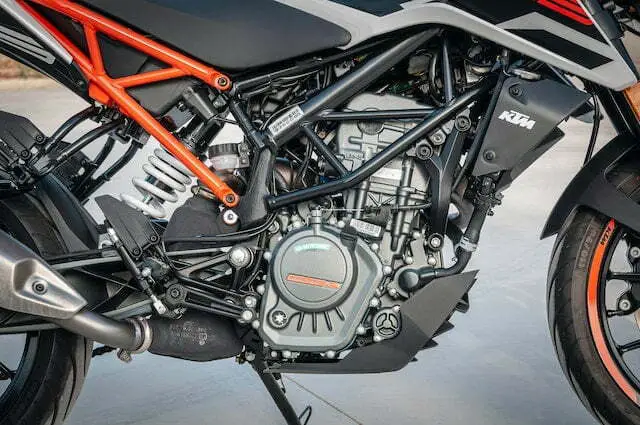As a motorcycle enthusiast, it is important to understand the technicalities of your bike.
One such important aspect is the compression ratio.
Often overlooked, the compression ratio is a critical component of an engine’s performance.
Motorcycle compression ratio is the ratio of the volume of the combustion chamber when the piston is at the bottom of its stroke to the volume when it’s at the top. A higher ratio means more compression and thus more power, but also higher risk of engine knock.
It determines the power output, fuel efficiency, and overall engine life.
So, if you’re wondering what exactly is a motorcycle compression ratio and how does it impact your bike’s performance, then you’ve come to the right place.
In this article, we’ll take a deep dive into everything you need to know about compression ratio in motorcycles. Let’s get started!
What is Compression Ratio
In simple terms, compression ratio is the ratio of the volume of gas in the cylinder when the piston is at the top of its stroke (top dead center) compared to when the piston is at the bottom of its stroke (bottom dead center).
The compression ratio is an important factor to consider when it comes to engine performance, as it affects power output and fuel efficiency.
It’s worth noting that the ideal compression ratio for gasoline engines falls between 8:1 to 13:1, which is why this range is commonly found in motorcycles.
Later in the article, we’ll explore how compression ratios vary in different motorcycle designs.

Theoretical Definition of Compression Ratio
Now that you have a better understanding of compression ratio, let’s dive deeper into its theoretical definition.
As mentioned earlier, the compression ratio is the ratio between the largest and smallest cylinder volumes.
This ratio is crucial for determining an engine’s overall performance, as a higher ratio allows for more air and fuel to be compressed, leading to increased power and efficiency.
Calculating the compression ratio involves measuring the volume of the cylinder at its largest and smallest capacities, and dividing the larger volume by the smaller one.
Understanding the theoretical definition of compression ratio is essential for optimizing your motorcycle’s performance and getting the most out of your engine.
Have a look at the video below that will demonstrate this concept visually.
Calculation of Compression Ratio
Now that you know what compression ratio is and how it can affect your engine, let’s dive into the calculations.
As mentioned earlier, the compression ratio is the ratio of the volume of the cylinder and its head space, including the pre-combustion chamber if present.
To calculate this ratio, you will need to measure the displacement volume (Vd) of your engine, which is typically measured in cubic centimeters (cc).
Next, measure the combined volume of the combustion chamber, head gasket, and piston dome.
Once you have these values, you can use the formula to calculate the compression ratio (CR).
Remember, the optimal compression ratio for gasoline engines varies depending on the application, so it’s crucial to do your research before making any modifications to your engine.
Keep in mind that racing engines typically have higher compression ratios due to their need for maximum power output.
However, make sure to stay within your engine’s limits to avoid causing any damage.
Range of Compression Ratios in Modern Motorcycles
So, now that we know what compression ratio is, let’s take a look at the range of compression ratios in modern motorcycles.
Generally, compression ratios on modern bikes range from as low as 9.5:1, like that on the Suzuki DR650SE, to as high as 14:1, such as on the Kawasaki Ninja ZX-14R.
This range reflects the different needs of different types of motorcycles.
For example, low-stress bikes like cruisers tend to have lower compression ratios, while racing bikes require much higher ratios to achieve maximum power.
But no matter what type of bike you have, it’s important to maintain the ideal compression ratio for its gasoline engine, which falls between 8:1 to 13:1.
Low-Stress Motorcycles and Older OHV Designs
Now, let’s dive deeper into low-stress motorcycles and older OHV designs.
These types of bikes often have compression ratios ranging from 7:1 to about 9:1. This is because they are not built for high-performance racing, but rather for cruising or for more vintage models.
These bikes will have larger combustion chambers to accommodate the lower compression ratios, resulting in a more relaxed riding experience.
If you’re a fan of classic bikes, or simply looking for a more comfortable ride, then these low-stress motorcycles and older OHV designs may be just the thing you’re looking for.
Comparison of Compression Ratios in Racing Engines
Let’s take a closer look at how it affects racing engines.
Racing engines typically have higher compression ratios than their street counterparts, as they are designed to produce more power.
In fact, it’s not uncommon to see compression ratios of 14:1 or higher in racing engines.
These high ratios allow for more efficient combustion, resulting in more horsepower and torque.
However, it’s important to note that racing engines also require higher-octane fuel to prevent detonation or “knocking”.
Overall, the compression ratio is a crucial factor in determining the performance of a racing engine, and it’s one of the many variables that engineers must consider when designing high-performance motorcycles.
CR Range for Optimum Power
Now let’s dive into the CR range for optimum power.
As we’ve learned, a compression ratio of 7 is generally preferred for most motorcycles running on 91 octane fuel.
But why is this the case? It’s because a higher compression ratio means that the engine is extracting more work out of the fuel, resulting in increased power output.
However, it’s important to note that going too high on the compression ratio can also cause engine knock or pre-ignition.
So, it’s best to stick to a CR range of 5 to 8.5 for the best power output on 91 octane fuel.
Keep in mind that factors like stroke length and valve overlap can also affect the ideal CR range, so it’s always best to consult a professional mechanic or engine builder for the best results.
Wrapping up
Now that we have a better understanding of compression ratio, let’s discuss the ideal ratio for gasoline engines in motorcycles.
As mentioned earlier, the optimum compression ratio for motorcycles usually falls between 8:1 to 13:1. However, it’s important to note that the ideal ratio may vary depending on the type of engine and its intended use.
For example, a lower compression ratio of 7:1 to 9:1 may be suitable for low-stress motorcycles or older models, whereas racing engines may require higher ratios in the range of 14:1 or more.
Ultimately, the ideal compression ratio for your motorcycle will depend on factors such as fuel quality, ignition timing, and engine design.
It’s always a good idea to consult your motorcycle’s manual or a professional mechanic for advice on finding the optimal compression ratio for your specific bike.



